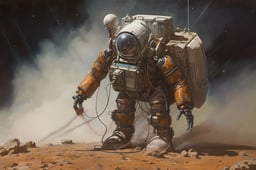As someone who worked as a quantitative consultant and data scientist for several years, I used to be skeptical about the near-term potential of AI technologies like recommendation engines and chatbots. However, recent advancements in Generative AI, powered by large language models (LLMs) like OpenAI's ChatGPT and Google's Bert, have astonished me.
These LLMs can now perform tasks like writing essays or code, passing exams, and engaging in in-depth conversations on various subjects.
This progress has reignited debates on AI's potential impact on our society and economy, including concerns about automation and job loss. In this blog, we'll objectively explore the potential effects of generative AI on the workforce, discuss the implications for white-collar jobs, and offer suggestions for preparing for a future driven by transformative AI. You can also discover What Leaders Need to Know About Implementing AI Responsibly in our separate webinar.
Elevate Your Organization's AI Skills
Transform your business by empowering your teams with advanced AI skills through DataCamp for Business. Achieve better insights and efficiency.
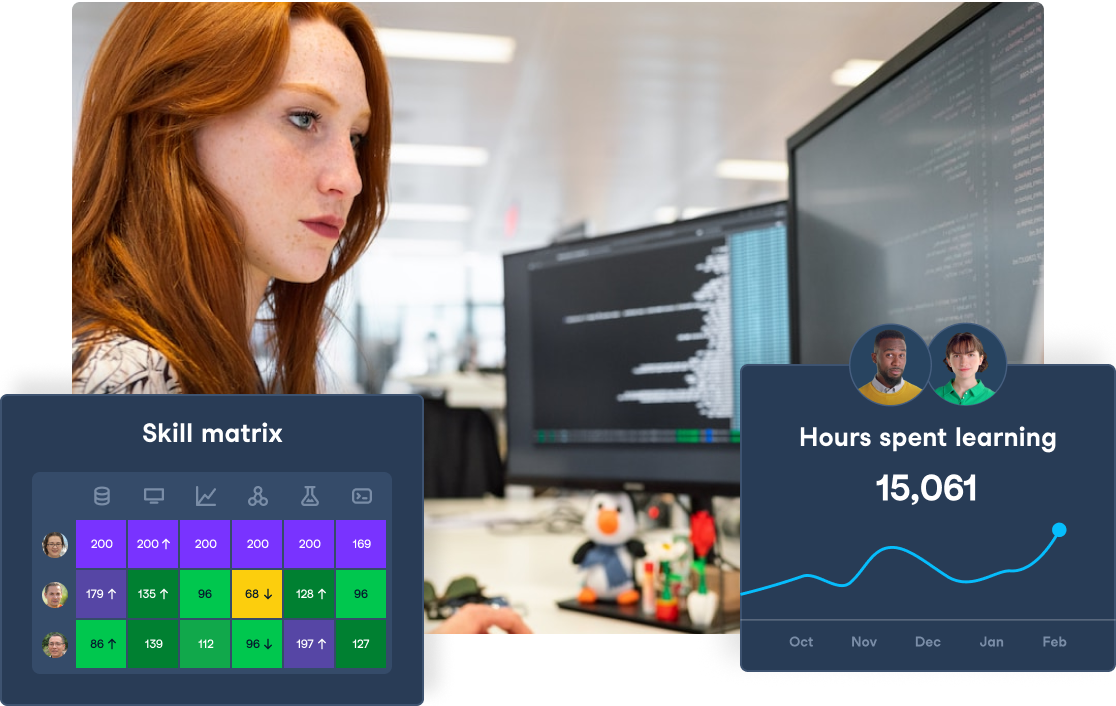
A Brief History of Technology’s Impact on the Workforce
Before we explore the potential impact of generative AI on jobs today, let’s briefly explore how technology has affected our work and the economy at key points in recent history (see, for example, Acemoglu, 2002).
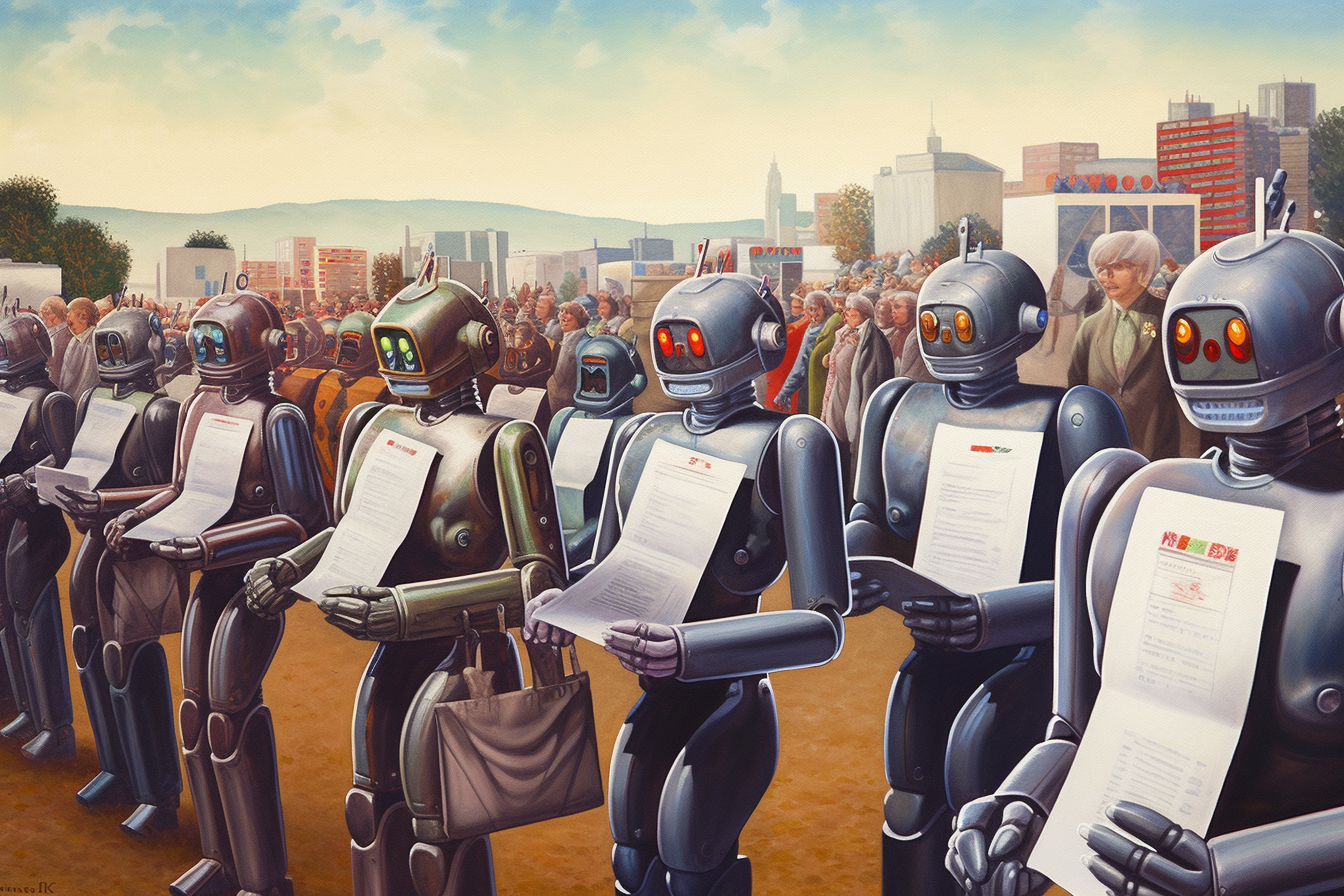
1770 to 1970: Automation Contributed to Rising Productivity
In the 19th century in Britain, low-skilled labor was abundant while highly-skilled workers were scarce. During this time, factories simplified and automated skilled artisan jobs such as cotton spinning in the textile industry. This led to substantial productivity gains but also to protests such as the Luddite riots, in which craftsmen destroyed machines to prevent precisely this automation.
A similar development happened in the early 20th century with the introduction of the assembly line, which increased (massively) the demand for repetitive, low-skilled jobs. Since the 1970s, however, this was the exception: since then, new technologies have mostly benefited high-skilled workers by replacing un- or semiskilled routine tasks often performed by middle-class jobs, as described in the following section.
An example here is the widespread automation in the agricultural sectors, first through horse-powered machines and then through the combustion engine that substituted arduous manual labor.
1970 to 2010: Automation Contributed to Rising Inequality
When I finished my Ph.D. in labor economics and statistics a few years ago, we witnessed four decades of rising wage inequality. This rise was, to a large extent, the effect of increased demand for better-educated workers (in combination with downward pressure on wages for jobs that could be offshored). Other causes, of course, also play an important role here, such as the decline in union coverage.
It was a surprising trend since the educational expansion led to a vast increase in the supply of highly-educated young graduates during the same period. Unintelligent automation such as robots, combined with offshoring, was implemented widely, particularly in manufacturing, and replaced former middle-class jobs, often inhibiting routine tasks prone to automation (see Autor et al., 2022).
Examples include repetitive assembly tasks, picking or sorting, and record-keeping or calculation. Microsoft's Excel clearly changed typical office jobs, and jobs like bank tellers or switchboard operators mostly disappeared. At the same time, we have not experienced a jobless world because careers not known before appeared, such as data analysts, wind turbine technicians, or mental health counselors. The appearance of these jobs is not directly an effect of automation, but automation and increased productivity freed us to focus on new domains.
These new technologies' overall macroeconomic effects were less than hoped for. Productivity increases have slowed down noticeably since the early 1970s (with a short exception around the dot-com bubble in the late 1990s, see Moss et al., 2020). Nobel laureate Robert Solow described this in his well-known productivity paradox: “You can see the computer age everywhere but in the productivity statistics."
There is a wide debate about the exact reasons why computers have not made us more productive (e.g., measurement error or seemingly free products like Wikipedia or social media), but the exact reasons remain controversial. What is undebated is the fact that productivity growth is only around half as large as in the thirty years following World War 2.

2010 to COVID-19: Employment Growth in the Absence of AI and Pandemic-related Technological Progress
While recovery (and productivity growth) were disappointing following the Great Recession, the demand for labor was strong, or as The Economist titled in 2019: “The rich world is enjoying an unprecedented jobs boom. “ These employment gains were largely driven by factors unrelated to new technologies, such as economic stimulus, low-interest rates, and increased female labor market participation.
Firms started to hire AI-related specialists around 2010. The trend accelerated again around 2015, and there is some evidence that those businesses reduced their hiring in other company segments. Still, until the COVID-19 pandemic started, there is little evidence that initial machine learning models impacted employment or wages (see, for example, Acemoglu et al., 2022).
The COVID pandemic had an unforeseen impact on businesses and jobs that would have otherwise taken a decade to unfold. Teleworking and home office became widespread; while pre-covid just around 5% of all working days were done from home, this jumped to 60% at the heyday of the pandemic and has remained at around 30% since (see Bloom et al., 2023). Many companies also spurred their investments in automation, for example, through robots or self-checkout machines.
How Will LLMs Affect White-Collar Jobs?
This small historical excursion demonstrates that the impact of technological change on jobs is unclear. Economists say it can be either skill-replacing (such as in the 19th century) or skill-augmenting (such as in the 20th century).
In modern economic models, sometimes called the revisited canonical model (Acemoglu and Autor, 2011), we assume that jobs consist of a bundle of tasks and there are different human skills or education groups, each with their own comparative advantage.
These groups can substitute for each other, but only imperfectly. Whether new technologies will replace certain skill groups depends, among others, on the demand for specific tasks, the supply or availability of these groups, and on their wages.
Overall, we have seen faster-aging advanced countries such as Germany, Japan, and South Korea adopt more robots in response to the scarcity of production workers. Firms have the incentive to invent and adopt skill-replacing technologies if there are not enough high-skilled workers, if the wages of high-skilled are high, or if there is a skill mismatch between what is demand and what is available. At DataCamp, we actively make certain in-demand skills available to as many people as possible!
Interestingly, until recently, many people probably would have thought that new artificial intelligence, such as automotive cars, would, in the first instance, replace blue-collar jobs such as truck or train drivers. However, recently launched Generative AI applications show remarkable skills typically done by white-collar workers, such as writing essays, doing background research, or programming.
Let's ask LLMs such as ChatGPT which tasks it might automate.
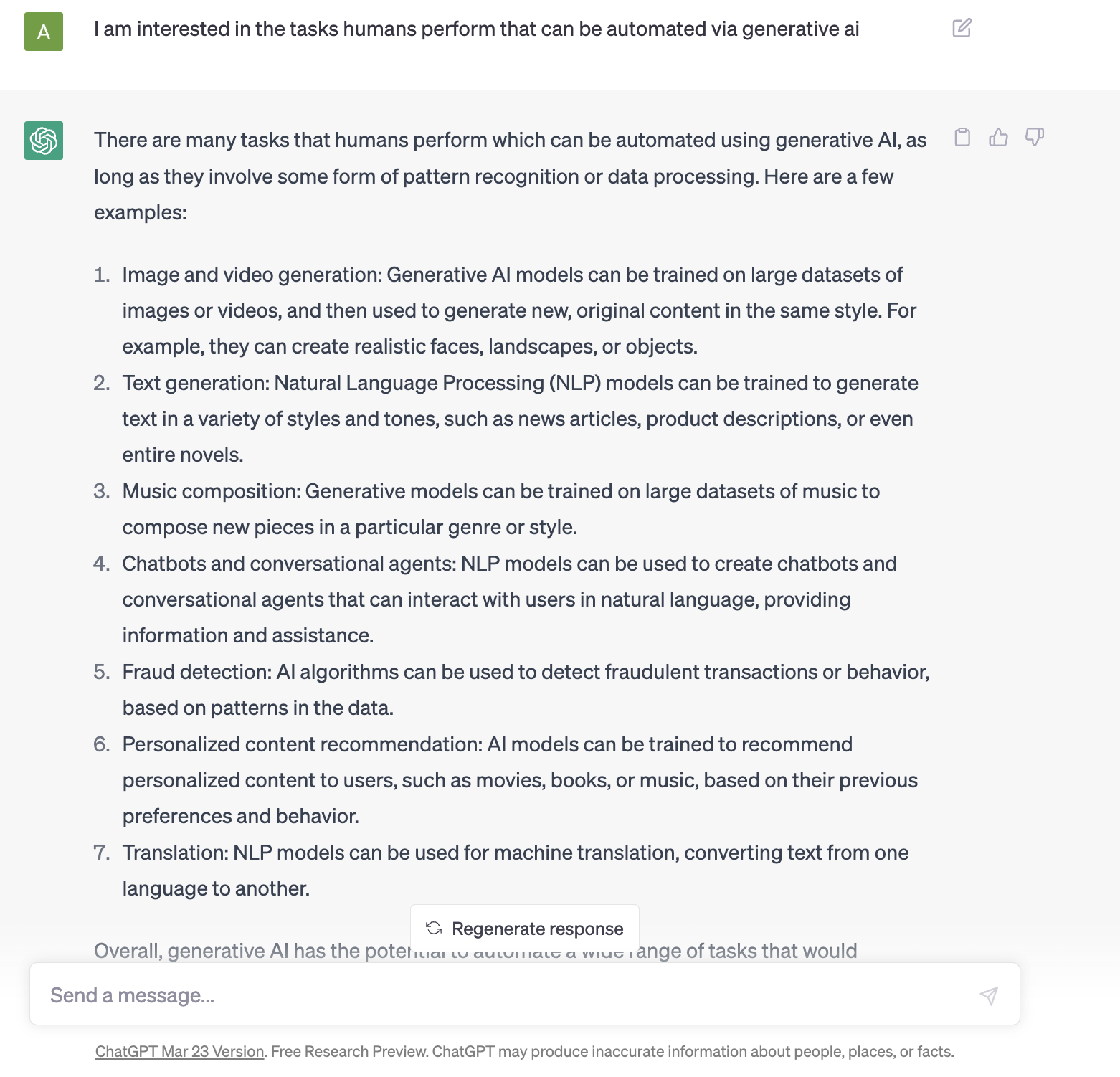
It suggests translation, text, image, video generation, music composition, conversational agents, or personal recommendations. This list highlights why some studies suggest that Generative AI might more impact higher-earning occupations. These jobs include language, literature, history teachers, legal services, finance, insurance, and accounting jobs (as discussed by Felten et al., 2023).
Even though the impact of Generative AI on education will probably be profound, think of AI assistants that allow students to learn at their own pace. Still, it seems unlikely that teaching positions will be replaced in a significant number (since they have crucial roles beyond what a chatbot might teach you) soon. However, Generative AI's progress in image, text, and audio recognition might have profound implications on (background) research, medical diagnosis, customer service, or (data) analyses.
This does not mean that radiologists, translators, or accountants will disappear, but it might be the case that these jobs will look very different in the future. Giving doctors (hopefully) more time to focus on patients and freeing them from basic administrative tasks.
OpenAI's and Goldman Sachs’ Estimate of Job Impacts
A study co-authored by OpenAI, the founders of ChatGPT, considers the new LLM models as general-purpose technology that first can be adopted into a versatile set of workflows across many domains, second continuously improves, and third leads to complementary innovations and spillovers.
They estimate that 15% of all tasks performed by the workforce in the United States might be performed significantly faster through LLMs. If additional complementary technologies are added, this figure could exceed half of all tasks.
Examples of strongly exposed tasks are writing and coding, while science or critical thinking are not. Exposure is calculated here whether "an LLM or LLM-powered system would reduce the time required for a human to perform [...] or complete a task by at least 50 percent". They find, in general, that jobs requiring more education, training, and experience tend to be greater exposed.
Goldman Sachs estimates that two-thirds of all jobs in the United States will be at least partly affected by Generative AI (with 25% - 50% of their tasks potentially being automated). They, however, do not expect mass layoffs and see Generative AI generally more as technology complementary to humans than substituting them.
The Short-Term Impacts of Generative AI
This is likely an upper limit in the short- to medium-term impacts since new technologies usually require some adoption time. Generative AI will likely be adopted faster than, for example, the internet, which took one or two decades until it became truly mainstream.
Legal and ethical questions surrounding generative AI adoption
Still, even new technologies will face certain barriers to overcome. There are legal questions that are particularly relevant in highly-paid white-collar occupations and unknowns to automating tasks in education, medicine, or professional services.
Who would be, for example, liable if Generative AI does make a mistake, or what about potential Copyright infringements due to crawling massively through the web to train such a model? And one should add that even the companies publishing recent LLMs acknowledge that these models sometimes fail spectacularly (and it seems complicated to assess precisely why).
Disruption of specific jobs by generative AI
These hurdles are not equally relevant for all white-collar jobs. Generative AI might well, and probably is already, disrupt specific segments of our labor market. Think of marketing that often includes drafting fairly generic texts or customer support where chatbots improve massively. LLMs seem so capable of translating, synthesizing, and even interpreting texts that it is hard to imagine that we will require a similar number of translators in the future.
Tools such as Google Translate or DeepL are already excellent, and Google’s BERTs first use case was exactly translation. Next, relatively simple software development jobs and standard content creation in media and education might be outsourced to machines to a certain extent, as are paralegal or tax preparation tasks.
Customer service jobs will undoubtedly be affected due to the immense progress in conversational support tasks. For example, a just-released working paper, co-authored by Erik Brynjolfsson, estimates that Generative AI has increased the performance of more than 5,000 customer service agents by ca. 14% on average, primarily for newer workers but hardly for the more experienced agents.
The effect of outsourcing to machines (automation) and outsourcing to foreign countries (offshoring) is for the affected workers very similar. Their jobs will be either codified and performed locally by cheaper robots or might be electronically transferred or physically shipped to other countries and done by cheaper labor.
The Long-Term Impacts of Generative AI
The impact of Generative AI on our economy in the medium- to long-term will certainly be profound. If combined with other technologies, such as robotics, most jobs will be affected to a varying degree (though kindergarten teachers, servers, or social work is still, for the time being, a safe bet).
We have seen demand and wages increase, particularly for high-skilled jobs, in recent decades, while the number of middle-class jobs has declined, and wages for low-paid jobs often stagnated. But we also witnessed another trend that led to a polarization in the labor market: an uptick in demand for service jobs, often low-paid. These include delivering packages, filling supermarket shelves, warehouse work, and personal services such as cleaning, security, or caring for the youth or older people. Consider adding here truck, rail, or Uber drivers.
Three possible scenarios for the future of generative AI development
Many of these jobs might be susceptible if automotive technologies advance further and robots become both intelligent and better capable of non-trivial 3D tasks. I could imagine here three different scenarios:
- We’re witnessing an inflection point, and Generative AI is a breakthrough technology like the printing press, steam engine, or transistor manufacturing, resulting in significant changes in how we work and live, with continuous improvement expected in the medium term.
- Generative AI may require decades of development before it can safely replace human tasks beyond specific areas, such as self-driving cars, which face limitations in safety without human supervision, despite significant improvements a decade ago.
- Current technologies may have already reached their peak, and there isn’t much more to come, similar to search engines where Google's PageRank revolutionized search (taking the market share from Yahoo! and Altavista) in the early 2000s, leading to incremental progress since then.
Of course, we do not know which of these scenarios will play out, but I am much more optimistic (and partly uneasy) that we just see a transformative technology gathering steam than at any time since the early days of the internet.
Are we Heading for an AI Utopia or an AI Dystopia?
Will these developments lead to a dystopian future where few jobs remain that primarily include either direct face-to-face interaction with other humans, developing and maintaining these new technologies, or complex or particular manual tasks?
I do not think so.
We are usually good at inventing new roles that complement technology or do something completely new (such as data scientists, drama therapists, or tattooists). This is why I am not concerned about a jobless future.
Nonetheless, were I a company leader, I would consider the potential impact on my business very seriously and think strategically about how to react and whom to hire.
As an individual, I would also think carefully about the skills I want to invest in and whether these are susceptible to automation through clever machines.
As a policy-maker, I would further encourage education, revise the educational curriculum, raise awareness that we might be at an inflection point, and avoid lurking particularly young people in automated jobs soon.
Take it to the Next Level
What can you, individually, as someone responsible for your business' success or other people do to make the best out of Generative AI?
I think, as of today, the chances are significant that we actually might see a new groundbreaking technological change unfold. Therefore, I strongly recommend understanding the basics behind Generative AI to determine how to react best.
How can you do this? You could, for example, learn ChatGPT with DataCamp's Introduction to ChatGPT course (and additional courses we will release soon) or some of our other resources, such as our Guide to Using ChatGPT For Data Science Projects or our OpenAI API in Python Cheat Sheet.
Of course, I suggest trying out these new technologies yourself and generating a few prompt streams. If you know more about LLMs, you can also read some of the research articles linked below and keep updated about new developments.
Sources:
Training 2 or more people? Check out our Business solutions
Get your team access to the full DataCamp library, with centralized reporting, assignments, projects and more

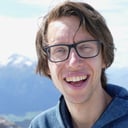
Arne heads the emerging curriculum team at DataCamp which focuses on new and emerging technologies and practices. Additionally, he is a guest lecturer at University of Heidelberg for data science and machine learning, he holds a PhD in economics & statistics and has climbed up to 7a+/5.12a outdoors.

